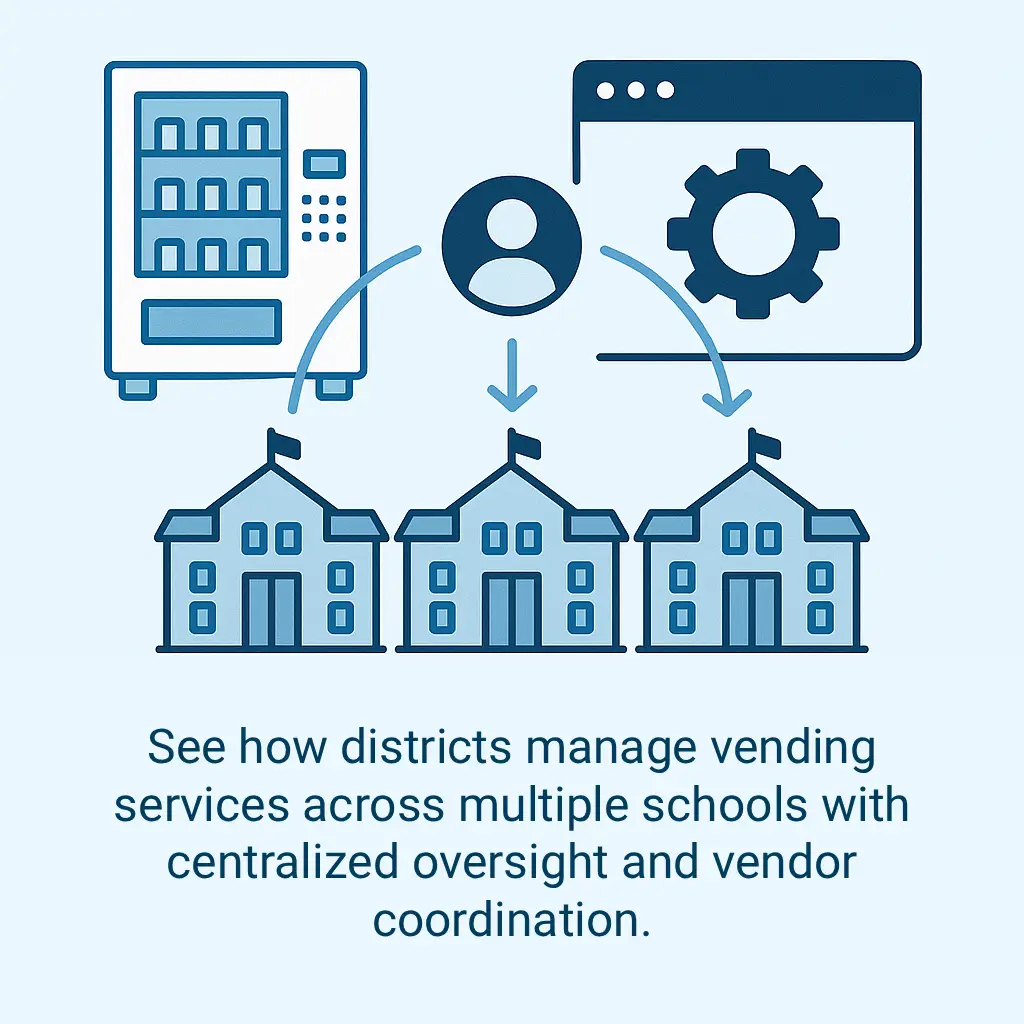Vending Solutions for School Districts
See how districts manage vending services across multiple schools with centralized oversight and vendor coordination.
Back to Vending for Schools ResourcesSee how districts manage vending services across multiple schools with centralized oversight and vendor coordination.
Back to Vending for Schools ResourcesDistrict-level vending oversight helps ensure consistent service, pricing, product standards, and accountability across all campuses. It allows centralized tracking, faster issue resolution, and simplified coordination with vendors assigned to each location.
![]() District oversight improves vending reliability across all campuses
District oversight improves vending reliability across all campuses
![]() Central coordination streamlines vendor relationships and reporting
Central coordination streamlines vendor relationships and reporting
![]() Smart machines support contactless payments and healthier choices
Smart machines support contactless payments and healthier choices

Managing vending across a school district presents unique challenges—especially when coordinating services for multiple campuses, maintaining healthy product options, and ensuring vendors remain reliable. With centralized control and clear coordination, districts can streamline vending operations while meeting diverse student and staff needs.
Districts benefit from maintaining control over vendor selection and performance oversight. Rather than each school independently contracting with different providers, a district-led approach ensures consistent service standards, unified product policies, and simplified billing or reporting where applicable. This leads to fewer issues with expired items, empty shelves, or service disruptions.
Popular vending options include glass-front beverage machines, snack-only setups, and combination machines offering a variety of healthy choices. In larger middle and high schools, micro markets or AI coolers provide expanded selections in a secure, open-access format. These solutions support modern expectations like tap-to-pay, inventory tracking, and real-time restocking alerts, which aid in both efficiency and monitoring student purchase habits when permitted.
It’s important to choose vendors experienced in working with K–12 environments. Reliable providers are responsive to school-hour access requirements, adhere to nutrition standards, and can rotate products seasonally to maintain student engagement. With managed service agreements, districts can also specify technical uptime thresholds or require routine maintenance—even across remote campuses.
An added benefit of centralized vending is better data collection. When vending tech includes cloud-based reporting, district administrators gain visibility into machine performance, sales patterns, and vendor responsiveness. This transparency supports more informed decisions over time—whether evaluating healthy eating trends or forecasting revenue-sharing results.
Districts evaluating newer technologies may also weigh security features of AI coolers for open-access environments or consider the pros and cons of working with national versus local vendors that specialize in school setups.
If you're exploring vending options for your business, Vending Exchange can help simplify the process. Delivery, Installation and Equipment is provided at no cost to you - vendors provide the machines, keep them stocked, and handle all servicing. Whether you need a provider or full-service management, just fill out the form on this page to get started.
Districts can centralize vending procurement and vendor oversight to streamline performance management, enforce nutrition policies, and standardize service across all campuses.
Common issues include broken machines, missed restocking visits, expired products, and vendors who are slow to resolve service complaints.
Yes, districts can specify machine types, product mixes, and nutritional limits based on each school's age group and dietary guidelines.
Combo machines are ideal for snack/beverage flexibility. In larger schools, micro markets or AI coolers can offer broader selections in a secure setup.
Many vendors offer cloud-based dashboards that provide real-time restocking data, sales reports, and machine uptime for better district oversight.
Yes, most modern machines offer tap-to-pay and mobile wallet compatibility, reducing physical contact and speeding up transactions for students.
Healthier products include dried fruit, trail mix, 100% juices, baked chips, and low-sugar beverages, often required by state or local guidelines.
Qualified locations can typically have machines delivered and installed within a week when coordinated through a district-level request.
Yes, vendors can provide separate reports by machine or location, helping districts manage revenue-sharing agreements and track performance.
Consider vendors with school experience, proven service response times, and the ability to meet district-wide nutritional and operational standards.